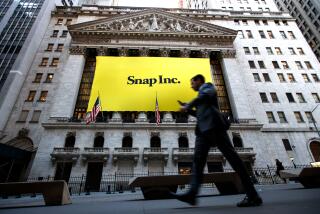What it’s like wearing Snapchat Spectacles

Spectacles — the debut camera from Los Angeles start-up Snap Inc. — might be the first camera ever sold with most of its technical specifications withheld.
- Share via
For decades, from Kodak to Polaroid to GoPro, companies have marketed cameras by touting features such as focal length, image size and memory space.
Spectacles — the debut camera from Los Angeles start-up Snap Inc. — might be the first capture device ever sold with most technical specifications withheld.
Snap refuses to reveal the megapixel-measurement of Spectacles’ image sensor, the exact capacities of its storage and battery or details about other components.
The secrecy reinforces how Snap’s inventions are designed to break from tradition. The company rose to popularity with a self-destructing message app, Snapchat, that countered Facebook’s emphasis on preserving conversations. Now with lightweight sunglasses that record video, Snap is suggesting to users that the details of cameras shouldn’t matter. The attention should be on whether the Spectacles sunglasses enable users to document life in a natural, in-the-moment way.
Blending in
In public, Spectacles users almost blend in. Even when a ring of small LED lights spins at the hinge, indicating the camera is recording, few passersby seem to bat an eye. It helps that in a country filled with selfie sticks, helmet-mounted GoPros and streets lined with surveillance cameras, many have grown accustomed to the idea that anything in public may be filmed.
When wearing Spectacles, it’s easy to forget there are sophisticated electronics attached to you.
Spectacles frames come in a low-key black, a laid-back teal and a much more in-your-face coral. They don’t look all that different from a pair of knock-off Ray-Bans, aside from the big yellow-outlined circles on each edge — one housing the camera and the other the ring of lights — and the slightly oversized earpieces and bridge.
Users look as goofy as anyone who wears the decorative swag given out at some fair booth. That’s a big improvement over Google Glass, the last notable attempt by a software company to develop eyepiece technology. Spectacles wearers won’t instantly be pegged as geeks or futuristic cyborgs.
How they work
More affordable and higher-quality options for video camera sunglasses exist, but they appear marketed toward James Bond wannabes and extreme sports athletes. Spectacles might feel expensive at $130. But what buyers get is a brand name, a look that wouldn’t feel out of place at Venice Beach or Coachella and one of the simplest cameras around.
Spectacles have made recording effortless. There’s something satisfying about just tapping one button to make a 10-second video. Bicycling, bowling, go-karting, dancing, tossing a baby into the air — just about any high-action activity immerses viewers with an eye-level perspective seldom captured before, and never so easily. But during more treacherous activities, a rugged and mountable camera such as the GoPro might be more suitable.
“It’s usable for most people today right out of the box,” said Gordon Wetzstein, a Stanford University assistant professor who researches next-generation electronics. “It’s a good test case to see if people want that experience.”
Spectacles aren’t perfect. They make boring wide shots and blurry night recordings. They don’t take stills and don’t zoom. And indoor usage is unlikely because wearing sunglasses inside is weird.
That has helped limit their utility to scenarios that generally come with lower expectations of privacy, said Michael Kim, a product design expert who founded Kim Advisory Capital.
Spectacles include a proprietary charging cable and a durably textured charging case, with extras for $10 and $50 respectively on Amazon.com.
Some details have emerged about the technology in the sunglasses from people who have torn their shades apart, including that the battery is about 5% of what’s packed in a smartphone. Snap has said Spectacles hold about 100 videos, suggesting at least 2 gigabytes of onboard memory. They’re manufactured in China by Goertek, according to regulatory filings.
Spectacles apparently have a motion-activated sensor too. Users can double tap the side of the frame, which lights up LEDs on the front to indicate the current battery level. A microphone is bundled somewhere.
Sharing and saving
In between the recording and the viewing, Snap still has work to do. Downloading videos to the Snapchat app on a smartphone is slow and buggy. Videos show up in high-definition on the owner’s phone, but they can’t be shared with others in HD. They record in a circular format that makes it possible to view videos in full-screen in both landscape and portrait mode on Snapchat, but they get cropped down significantly when viewed in other apps.
Snap organizes Spectacles videos into batches based on the day they were shot and uses an undisclosed algorithm to automatically point users to the best among them.
In the editing process, users can doodle on the 10-second videos just as they would a normal Snapchat video. They also can adorn them with geofilters, or digital stickers that mention a location. The geofilters available are dependent on where the Spectacles videos are imported — not where they’re shot.
Snap declined to list other data it associates with a recording, such as the specific pair of glasses used or the time the video was taken. Such metadata is stripped out and the file size reduced when Spectacles videos are exported to other apps from Snapchat.
Snap went a different route than traditional Snapchat videos when it comes to storage. By default, Snapchat tries to store videos on its servers for a very limited time. But Spectacles videos by default are backed up to Snapchat’s cloud permanently, meaning users should be wary when taking sensitive or scandalous shots with Spectacles. Snap holds the power to view videos, and potentially share them with law enforcement, unless the user marks them as “My Eyes Only.” Even in that case, some metadata remains unencrypted.
Flattening sales
Snap is only selling Spectacles through a limited-hours store in Manhattan that could shut down as early as Saturday and vending machines roving around the U.S. a day at time. The unusual sales strategy prompted big lines when Spectacles went on sale in early November. But the frenzy has subsided.
On resale markets such as Amazon.com and EBay, prices have tumbled. The average secondary market buyer paid $261 in December compared with $466 in November, according to an analysis of 137 receipts gathered by research firm Slice Intelligence. They were overwhelmingly purchased by young white men, Slice said.
On Google, searches for Spectacles have dropped by half in the last month. Research firms EMarketer and Hitwise found that about 124,000 people in the U.S. searched for “Snapchat spectacles” or “Snapchat glasses” during their first month available.
“That’s not an insignificant number but it’s barely a bug on the windshield compared to Snapchat’s U.S. user base, which EMarketer estimates at 58.6 million,” the company said.
What’s next
With a quick-launch camera, Snap has achieved a vital first step toward the types of wearable devices many technologists predict will become commonplace in the future. The missing half is a display technology. On the simple side, a display would show people what they are recording. But over time, the display could grow to become a replacement for smartphones — showing notifications, maps and videos.
Getting these head displays to work as imagined remains a challenge, Wetzstein said. Experimental products with both a camera and display such as Google Glass and Microsoft HoloLens look dorky, except if in certain workplaces, because they place clear visors in front of a user’s face.
An Indian billionaire says his new tech company is growing faster than Facebook and Whatsapp »
“Microsoft and Google have made progress,” he said. “But there’s a way to go to put something in the form of sunglasses.”
It’s unlikely Snap would release display-integrated Spectacles until it can making viewing more captivating than on a smartphone. But devices and their accessories appear core to the future of Snap, which since September has described itself as a camera company.
Kim hopes the next Spectacles model allows for live-streaming video to friends. In the more distant future, as people get more accustomed to wearing Spectacles and computing devices on their head, voice integration could be possible the same way Siri works on an iPhone.
“More … will be addressed through personalized voice in the near-term than through wearable cameras, but the two combined would be a very impressive combo,” he said.
A typical tech company might make modest upgrades to the next version of Spectacles, offer customized designs and provide more ways to buy them. But Snap’s strategies are hardly predictable. Rather than release a new version of Spectacles next, it’s possible the company could come out with a different variety of camera first.
Whatever’s next, Snap’s first take on cameras has given users new freedom and flexibility. Spectacles extend offline the fun of Snap’s playful app, even if only in 10-second bursts of excitement.
Twitter: @peard33
MORE TECHNOLOGY NEWS
Qualcomm is fined $865 million by South Korean antitrust regulator
Photoshop is hard to learn. Adobe thinks artificial intelligence can help
Amazon says its Echo devices were hot sellers during its ‘best ever’ holiday season







